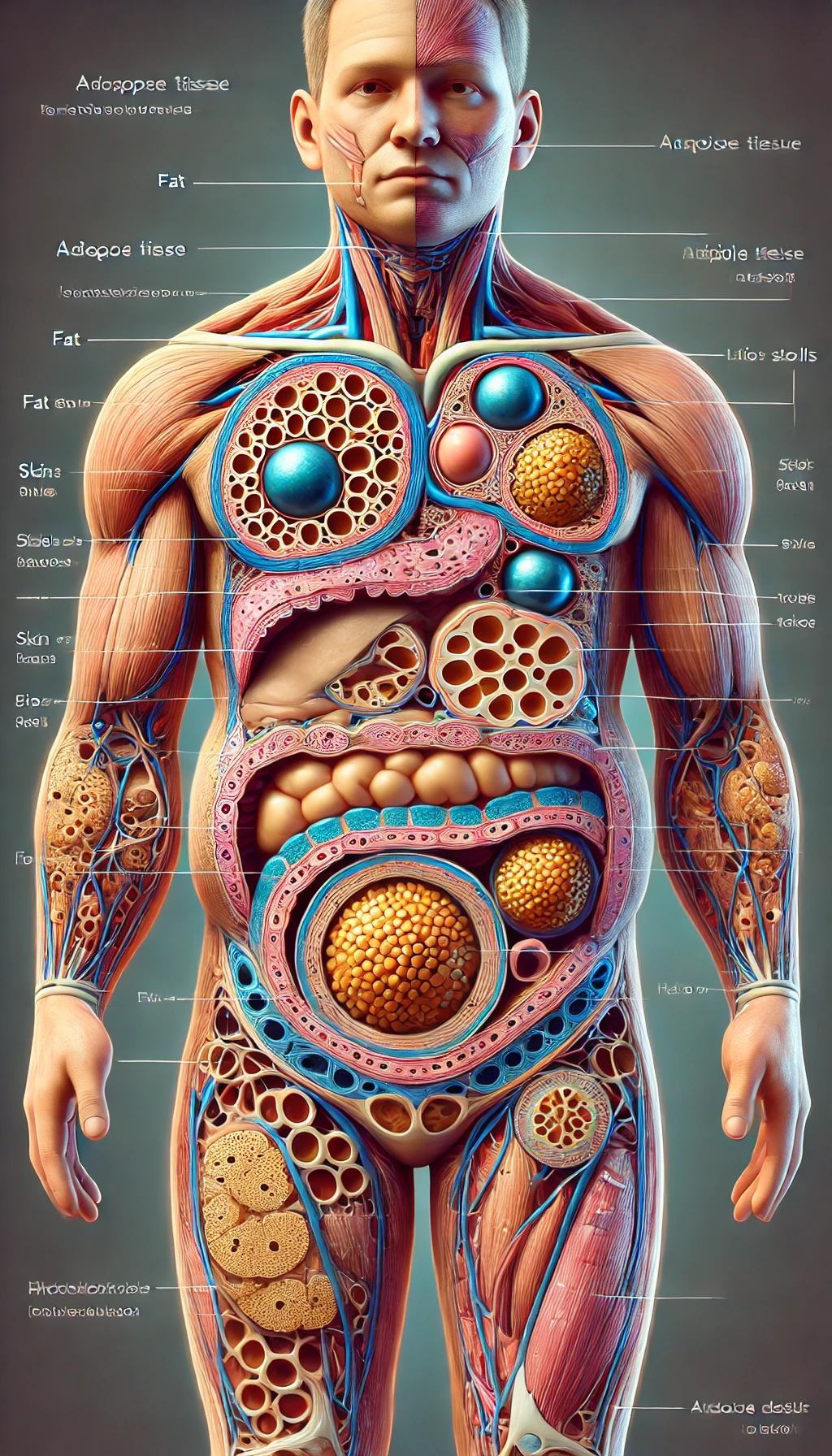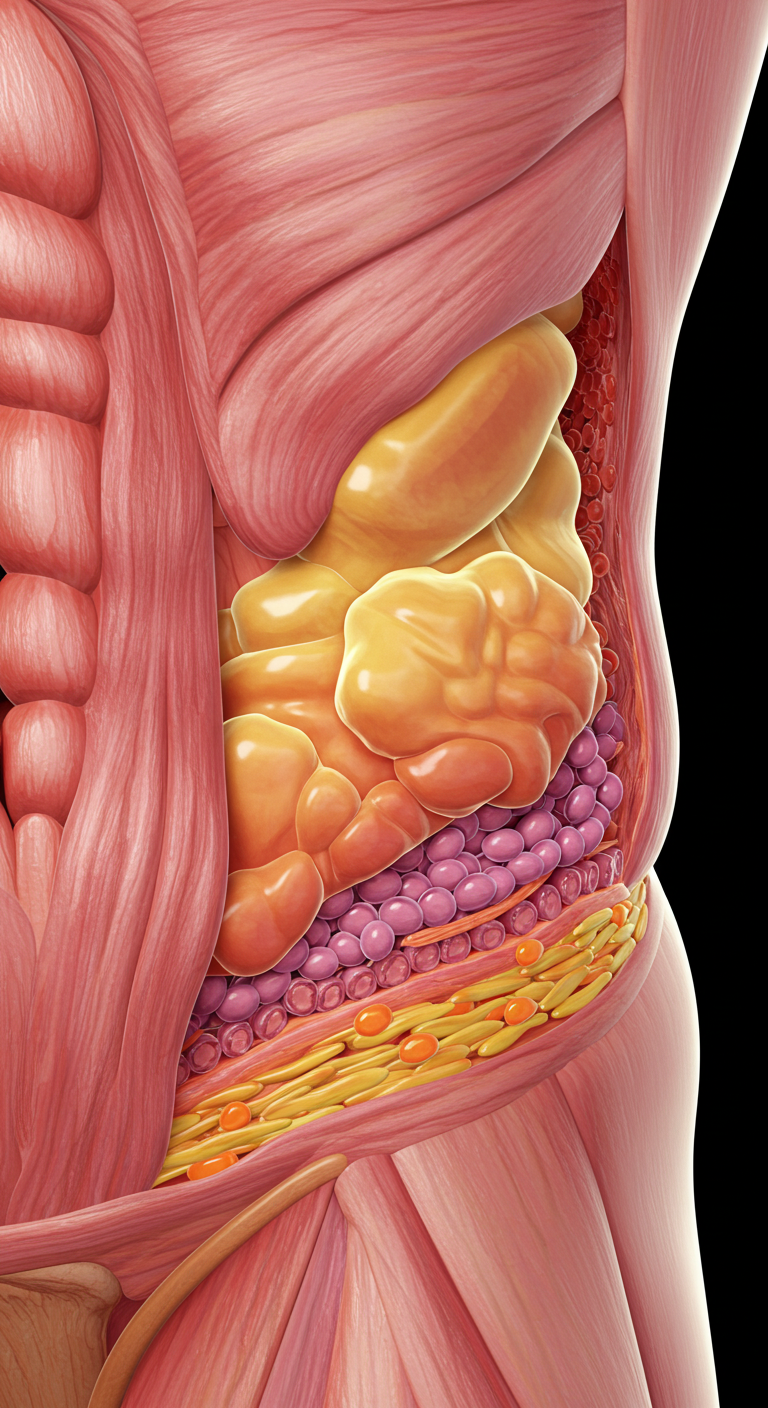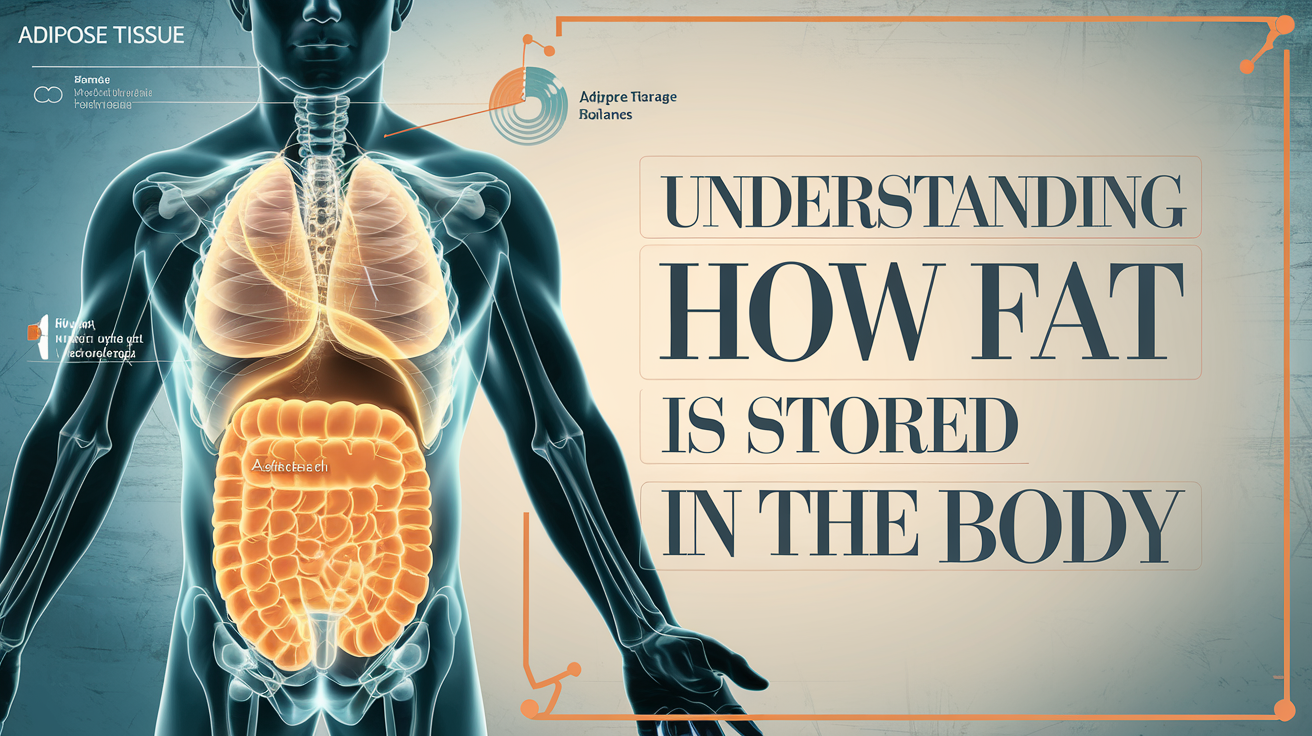Understanding Fat Storage in the Body
Did you know a healthy adult’s body stores 80-85% of its energy as fat? Yes, it’s true! Although people often view it negatively, it’s vital for our energy and health. Knowing how our bodies store fat helps us make better health and weight choices.
Fat storage is more complex than just accumulating calories. After eating, our bodies transform these nutrients into fat for later use. But if we eat more calories than needed, it can lead to an excess. This might cause obesity and other health issues.
Fat acts as a dense energy source, offering about 9 calories per gram. This is more than both protein and carbohydrates. Yet, it’s important to avoid too much. Too much, especially visceral fat, increases risk for diseases like diabetes and heart disease. Let’s go deeper into adipose tissue and fat management in our next sections. Prepare to be amazed!
What is Adipose Tissue and Its Role in Fat Storage?
Adipose tissue is more than just what we can pinch. It’s a key player in how our body manages energy and health. By learning about its types and roles, we understand how fat is stored and energy balance better.
Types of Adipose Tissue
Adipose tissue comes in two main types: white and brown. Each has its own job in the body:
- White Adipose Tissue (WAT): WAT stores energy as triglycerides. This is the body’s way of keeping an energy reserve.
- Brown Adipose Tissue (BAT): BAT is different because it burns energy to create heat. This helps protect against cold and fights obesity and diabetes.
Function of Adipose Tissue in Energy Regulation
Adipose tissue does more than store fat. It plays a big part in controlling metabolism with hormones and cytokines. This is how it impacts us:
- It sends signals about appetite and energy use to the brain and organs.
- During obesity, it can lead to inflammation and insulin problems because of macrophages.
- Even though adults don’t have a lot of brown adipose tissue, it helps in keeping our body warm and in using energy efficiently.
How Fat is Stored in the Body
Have you ever thought about how eating a slice of cake leads to extra weight? The body stores fat when we eat more calories than we need. Carbohydrates, proteins, or fats all can turn into fat. They get stored in adipose tissue for when we might need them later.
The Fat Storage Mechanism Explained
Eating foods like cereal and pasta makes your body get to work. It prefers to store energy as fat because fat has more calories. For every gram, fat has 9 calories. Carbs and proteins only have 4. So when there’s too much eaten, your body saves it as fat for the future.
Why the Body Converts Excess Nutrients to Fat
The liver and adipose tissue are where your body turns nutrients into fat. This is key for our survival. It provides energy for later, keeping our body balanced. Without it, getting through the day, especially when food is scarce, could be hard. This process shows the importance of knowing about fat storage for health and wellness.
Understanding the Lipid Storage Process
The way our bodies store energy is called the lipid storage process. It’s all about the balance of calories we eat and burn. When we consume more calories than we use, our body starts to store fat. This is because it converts extra energy into fat for future needs.
How Calories Influence Fat Accumulation
Calories are like energy money for our bodies. Eating too many calories starts a process that leads to storing fat. Here’s a simple breakdown:
- Extra calories turn into triglycerides, which have a lot of energy, much more than carbs and proteins.
- These triglycerides are then stored in our fat cells, waiting to be used when we need energy.
- If we keep eating too much, more and more fat cells build up, making us gain weight.
The Role of Hormones in Fat Accumulation
Hormones are super important in how we store fat. Insulin, for example, helps manage our blood sugar and fat. Too much insulin makes us store fat instead of breaking it down. Cortisol is another hormone that affects how we store fat:
- Cortisol can make us store fat around our belly, often because we eat more when we’re stressed.
- When our body turns extra carbs into fat, hormones help with this process in our fat cells or liver.
- Breaking down triglycerides, or fats from our food, is vital for keeping our energy up and our bodies working right.

Body Fat Distribution: Subcutaneous vs Visceral Fat
Let’s talk about belly fat: it’s not all the same. Body fat distribution plays a huge role in your health. There are two main types: subcutaneous fat and visceral fat. Knowing about these can help you understand the risks they carry. Let’s dive deeper into this topic!
Characteristics of Subcutaneous Fat
Subcutaneous fat is the type you can pinch. It’s found under the skin, especially on the hips, thighs, and belly. It stores energy and provides cushioning. But, it’s not all good news.
In fact, having subcutaneous fat on the lower body can protect against diseases. It’s good at storing dietary fat, which is better than the fat hiding deeper inside.
Health Risks Associated with Visceral Fat Accumulation
Visceral fat is the hidden fat around your organs. It’s not just about looks. It greatly affects your health, raising risks for serious problems like heart disease, diabetes, and some cancers.
Using the waist-to-hip ratio can reveal risks. Men with a ratio of 0.90 or higher, and women at 0.85 or above, are more at risk. And, having a waist over 40 inches for men and 35 inches for women means higher health risks.
Understanding body fat types shows why distribution is key to health. Staying away from visceral fat leads to better health and a balanced life.
Factors Contributing to Fat Cell Accumulation
Both genetics and environmental influences play crucial roles in fat cell accumulation. Understanding their interplay is key to a healthy lifestyle.
Genetics and Environmental Influences
Genetics majorly influence our body’s fat storage. About half of it’s distribution is due to genetics. Some people might gain it in specific areas, affecting their body shape and fat spread. For example, men often gain more visceral fat around their abdomen. Women usually store more fat in the gluteofemoral region. This leads to different health risks based on gender.
On the other hand, environmental factors like diet and exercise habits impact fat accumulation. Poor food choices and not moving enough can lead to more over time. Not sleeping enough has been linked to more visceral fat. People getting five hours of sleep or less may have almost three times more abdominal fat than those sleeping six to seven hours.

Health isn’t just about genetics. Environmental factors play a big role in fat accumulation. This highlights the value of lifestyle choices. Eating well, staying active, and sleeping enough can counteract genetic risks, leading to better health.
The Fat Metabolism Mechanism and Its Impact on Health
The path from storing to burning fat is key for good health. It helps us stay active by changing it into energy we can use. Eating too much can lead to obesity and health problems like heart disease and diabetes.
It’s important to match what we eat with how much energy we use. This helps us understand how our body deals with fat.
Our daily actions, influenced by our basal metabolic rate and NEAT, decide how many calories we burn. Being active through simple tasks like gardening can burn 100 to 800 calories a day. The Physical Activity Guidelines for Americans suggest 30 minutes of moderate exercise daily for weight control.
Knowing how fat metabolism works explains why weight is a struggle for some but easier for others. Our age, gender, and hormones affect how we manage it. Awareness of these factors can guide us in making healthier choices for our metabolism, fighting obesity, and enhancing overall health.
